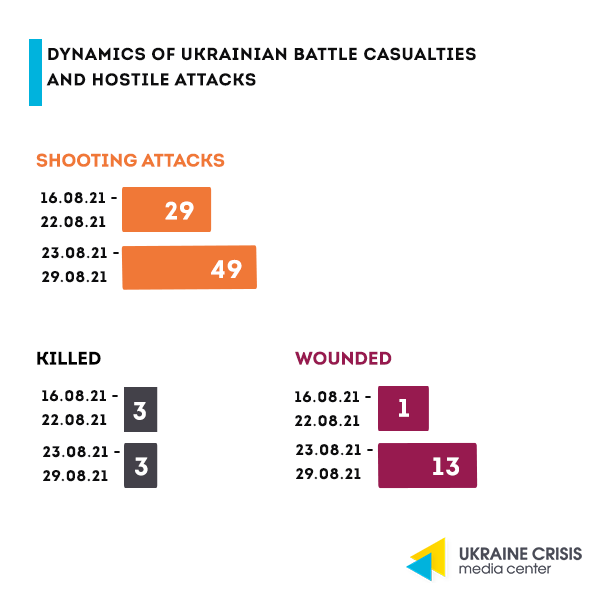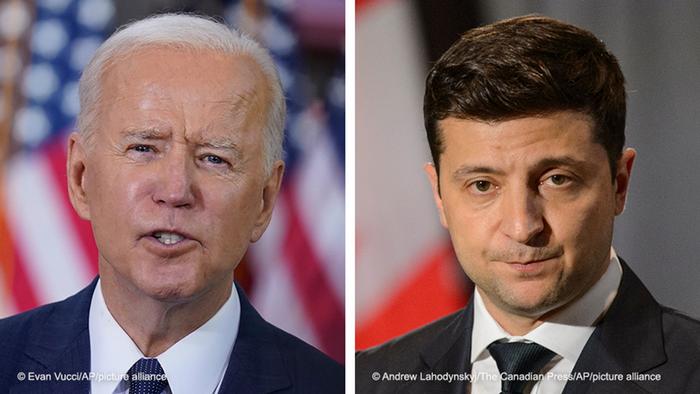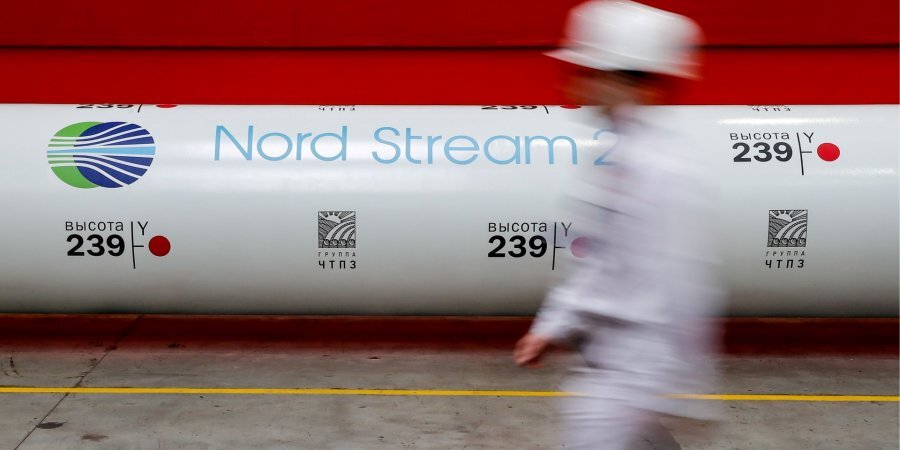Situation in the combat zone

In the combat zone, tensions mount. On August 29, Ukraine’s Joint Forces recorded nine ceasefire violations, a morning report by the Joint Forces command reads.
Near Shyrokyne, Russia-backed militants fired upon the Ukrainian troops’ positions from 120-mm mortars. Near Zolote-4, they fired from hand-held grenade launchers and small arms. Outside Prychepylivka, Russia’s proxies fired from under-barrel grenade launchers.
“Two service members of the Joint Forces were wounded in action. They were taken to hospital. One is in critical condition, the other is in fair condition,” the report reads.
Last week, tenser episodes occurred on the frontline. On August 28, the Joint Forces of Ukraine recorded 18 ceasefire violations.
“Six service members were wounded by shrapnel, four more were wounded in action. They were taken to hospital, their condition is fair,” a morning report by the Joint Forces command reads.
Attempts to derail the meeting between Zelenskyi and Biden. By escalating the situation in Donbas, Russia attempts to jeopardize the talks between the President of Ukraine Volodymyr Zelenskyi and the U.S. President Joe Biden, a statement by the Ukrainian delegation to the Trilateral Contact Group reads.
“The adversary aims to provoke an inadequate response, so that they can make a statement on Ukraine’s ‘aggressive acts’, create tension, and derail the talks between the Presidents of the U.S. and Ukraine on the conflict settlement including discussions on U.S.’s participation in the peace process,” the statement reads.
Russia-backed militants may also intensify the combat actions during President Zelenskyi’s visit to the U.S., the Ukrainian delegation to the Trilateral Contact Group warned.
Expectations of Zelenskyi-Biden meeting

On Wednesday, September 1, Volodymyr Zelenskyi and Joe Biden will meet in Washington. That is the first face-to-face meeting of the Presidents of Ukraine and the U.S.
President Zelenskyi’s visit coincides with a dramatic moment for the U.S. – the deadline for withdrawing the U.S. troops from Afghanistan on August 31. Following the Taliban takeover of Afghanistan and an airport attack in Kabul, Afghanistan remains at the top of the U.S. agenda.
Still, at the meeting with Biden, Zelenskyi is intent to bring to the table a series of subjects that Ukraine holds important including security and energy.
What is known so far about the visit’s agenda. The visit of President Zelenskyi is anticipated to be “not just a visit to meet with President Biden, but rather a visit to the U.S. in a wider sense,” Ukraine’s Foreign Minister Dmytro Kuleba said earlier.
The Ukrainian President is to meet with President Biden and his administration – the delegations will meet, and the Presidents will hold a one-on-one meeting, Kuleba said. Zelenskyi will also meet with the IMF representatives, and the Ukrainian community. He is set to meet with the American businesses in the information technology field and the space industry.
Ukraine’s Ambassador to the U.S. Oksana Markarova revealed details of the President’s agenda in the U.S. He will have meetings in Washington on August 31 and September 1, and will then travel to California.
Zelenskyi is set to meet with the secretaries of the Cabinet’s executive departments that are key to the U.S.-Ukraine relations. He and the first lady of Ukraine Olena Zelenska will hold two presentations for the media, think tanks, and representatives of the civil society. They will inaugurate the Ukraine House and visit Washington’s landmarks relevant to the U.S.-Ukraine context.
Expectations for the U.S.-Ukraine meeting. High on the agenda of President Zelenskyi is national security and new U.S.-Ukraine agreements in the field, reinforced military cooperation, and clearer and more realistic prospects of NATO’s Membership Action Plan for Ukraine. Meanwhile, key challenges facing Ukraine, as seen by the White House are the armed conflict with Russia and the need for progress in domestic reforms.
Ukraine’s analysts hope that the visit will bring new dynamics to the U.S.-Ukraine relations after the Trump era that saw Ukraine being pulled into the scandal around a phone conversation between Zelenskyi and then U.S. President. Trump’s attempt to press the President of Ukraine to open an investigation against Joe Biden’s son led to the impeachment of the 45th President of the United States.
Meanwhile, on August 24, Michael McFaul, U.S. Ambassador to the Russian Federation (2012-2014) and Special Assistant to the President and Senior Director for Russian and Eurasian Affairs at the National Security Council at the White House in the Obama administration (2009-2012) published an opinion column in The Washington Post calling on the White House to “reboot” relations with Ukraine. He suggested steps that would help Kyiv and Washington create a new “extraordinary relationship”.
If Ukraine’s democratic experiment falters under the pressure by Russia, there will be little hope for Biden’s democracy agenda when juxtaposed with authoritarian regimes, McFaul said. The U.S. needs to expand its support to Ukraine, the former diplomat who’s also a professor at Stanford University added. Success of Ukraine’s democracy will encourage democratic leaders in the region and throughout the world. Its failure will be beneficial for the Russian President Vladimir Putin and his authoritarian allies from Minsk to Beijing, McFaul concluded.
Nord Stream 2: defeat in court, retaliation by Gazprom and scheme by Rosneft

Nord Stream 2 AG, a Gazprom company, project operator of Nord Stream 2 lost a decisive court case in Germany. (Read also: “Project operator Nord Stream 2 AG loses court ruling in Germany: new complications facing Russia”). The company requested to make the pipeline exempt from the scope of the EU gas directive, but the Higher Regional Court of Düsseldorf dismissed the bid.
Under the EU gas directive, Gazprom will not be able to both own the pipeline and transport the gas. The pipeline is to be operated by a company unbundled from Gazprom. Besides, 50 per cent of the Nord Stream 2 capacities must be reserved for alternative suppliers.
Retaliation by Gazprom. Reaction by the Russian monopolist was telling. An hour later after the court ruling came out, a Gazprom company Gazprom Export stopped gas sales to the EU with delivery in 2022.
Gazprom’s e-sales platform shows that the last time if offered sales for the first quarter of 2022 was August 23. In the next days, on August 24 and August 26 it sold the contracts for 2023.
Starting August 25, Gazprom’s electronic sales platform offers sales for winter 2022-2023 and the year 2023.
On the evening of August 27, the gas price in the EU market exceeded USD 580 per 1,000 cubic meters, a more than six per cent increase from August 26.
A scheme Russia invents to bypass the EU gas directive. Meanwhile, Russia came up with a scheme to make Gazprom omit the EU regulations. Rosneft claimed willing to also supply gas to the EU – up to 10 billion cubic meters annually through the agent’s agreement with Gazprom. That formally meets the requirement laid out by the directive to have an “alternative supplier” that will use the pipeline’s capacities.
Ukraine’s stand. Ukraine is ready to offer competitive conditions for the gas transit to the EU that will also allow Russia to launch Nord Stream 2, said Chairman of the Board at Naftogaz Ukraine Yuriy Vitrenko following the talks with Georg Graf Waldersee, special representative of the German Federal Government for gas transit through Ukraine.
“Transit through Ukraine needs to stay for Europe’s safety, until natural gas is replaced with renewable energy, at least until 2035,” Vitrenko wrote on Facebook.
He pointed out what appears to be the most realistic plan to keep the gas transit through Ukraine:
-in the Gazprom contracts for gas transmission to the EU through Ukraine, move the gas receipt points to the Russia-Ukraine border, so that the EU companies would order gas transit through Ukraine by 2035;
-on the e-sales platform of Gazprom, create a gas supply point at the Russia-Ukraine border for extra volumes of gas, so that the EU companies could order gas transit through Ukraine;
-Russia needs to unblock the access to Ukraine’s gas transmission system for other gas exporters, particularly from the Central Asian states.
“These are not Ukraine’s whims, but practical implementation of the EU regulations, that Germany and the U.S. committed to abide by ‘both the letter and the spirit’ in the joint statement on Nord Stream 2,” Vitrenko said.
Gazprom needs to ensure equal access to all gas pipelines that run from Russia to the EU, including those that pass through Ukraine.
“The operator can be certified if the solidarity principle is respected, otherwise, Nord Stream 2 will not go into operation. If Russia refuses to play by the EU rules, Nord Stream 2 must never go into operation,” Vitrenko said.
How Ukraine is fighting COVID-19

In Ukraine, new case and death reports are rising. On August 29, Ukraine recorded 749 new coronavirus cases, 291 recoveries, and 18 deaths. Hospitalized were 583 people with suspected or confirmed Covid-19.
Projections of a new lockdown. State health authorities warn of a new lockdown in November. The Kyiv School of Economics projects that in September, a majority of Ukraine’s regions will move into the “yellow” or “orange” zone.
Vaccinations. In Ukraine, since the vaccinations began, 5,308,725 people have received the first dose of a Covid-19 vaccine, and 3,622,915 people have been fully immunized.
According to the Covid-19 vaccination plan, at least 5.6 million doses per month, or about 182,000 doses per day were to be administered in Ukraine beginning in May.
The Health Ministry aimed to administer 10 million doses by September 1. Yet despite the efforts to speed up the vaccine rollout, the state health authorities will reach the target later in autumn.




